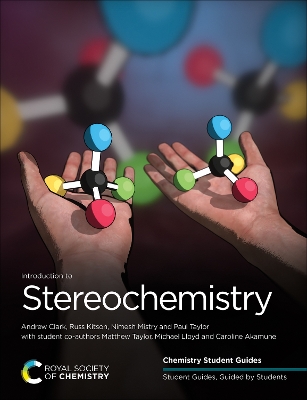Chemistry Student Guides
1 total work
Introduction to Stereochemistry
by Andrew Clark, Russ Kitson, Nimesh Mistry, Paul Taylor, Matthew Taylor, Michael Lloyd, and Caroline Akamune
Published 23 October 2020
CHEMISTRY STUDENT GUIDES. GUIDED BY STUDENTS
Why did the drug thalidomide cause birth defects? What is the chemical difference between sucrose and lactose in your food? Stereochemistry holds the answer and is essential to the understanding of the chemistry of life.
Stereochemistry is an important concept that often causes confusion amongst students when they learn it for the first time. Unlike most other areas of chemistry, it requires the chemist to visualise molecules in 3D, which can be difficult. In this book we deal with tricky concepts like conformation and configuration, how to represent them accurately and how to use the correct terms to describe them in both organic and inorganic chemistry. We involved students in the writing process to ensure we deal with areas that you find difficult, in an understandable language. With problems designed to focus on common errors and misconceptions, real life examples, and practical hands-on exercises coupled with visualisation tips, our intention is to give you the tools to become confident in stererochemistry.
Complementing mainstream organic textbooks, or self-study, this book is for anyone who has struggled with describing alkenes as E or Z, assigning R and S absolute configurations, drawing Newman projections or chair representations of cyclohexanes, axial chirality, understanding the stereochemistry of octahedral metal complexes and indeed explaining complexities observed in NMR spectra.
Chemistry Student Guides are written with current students involved at every stage, guiding the books towards the most challenging aspects of the topic. Student co-authors for Introduction to Stereochemistry are Caroline Akamune, Michael Lloyd and Matthew Taylor.
Why did the drug thalidomide cause birth defects? What is the chemical difference between sucrose and lactose in your food? Stereochemistry holds the answer and is essential to the understanding of the chemistry of life.
Stereochemistry is an important concept that often causes confusion amongst students when they learn it for the first time. Unlike most other areas of chemistry, it requires the chemist to visualise molecules in 3D, which can be difficult. In this book we deal with tricky concepts like conformation and configuration, how to represent them accurately and how to use the correct terms to describe them in both organic and inorganic chemistry. We involved students in the writing process to ensure we deal with areas that you find difficult, in an understandable language. With problems designed to focus on common errors and misconceptions, real life examples, and practical hands-on exercises coupled with visualisation tips, our intention is to give you the tools to become confident in stererochemistry.
Complementing mainstream organic textbooks, or self-study, this book is for anyone who has struggled with describing alkenes as E or Z, assigning R and S absolute configurations, drawing Newman projections or chair representations of cyclohexanes, axial chirality, understanding the stereochemistry of octahedral metal complexes and indeed explaining complexities observed in NMR spectra.
Chemistry Student Guides are written with current students involved at every stage, guiding the books towards the most challenging aspects of the topic. Student co-authors for Introduction to Stereochemistry are Caroline Akamune, Michael Lloyd and Matthew Taylor.
